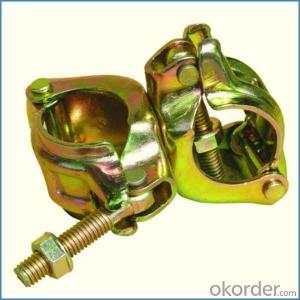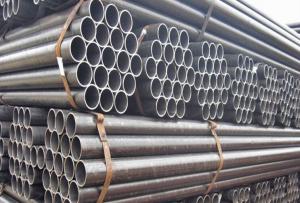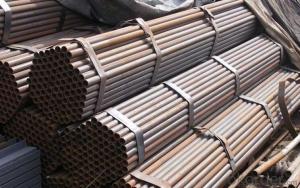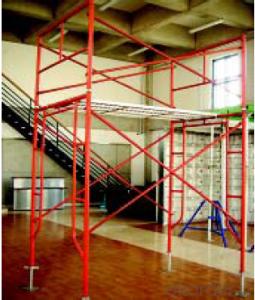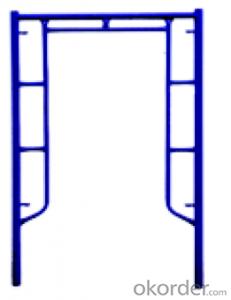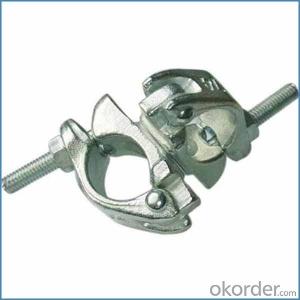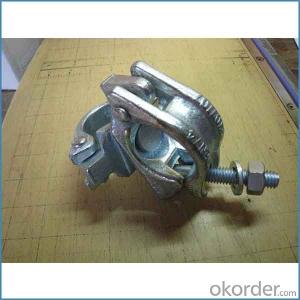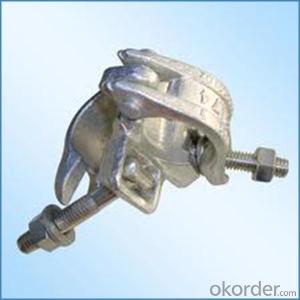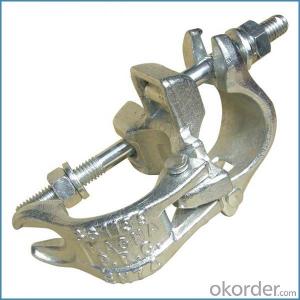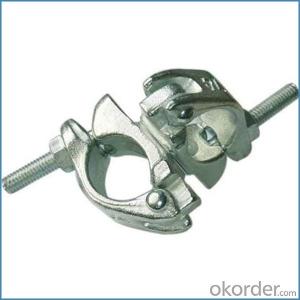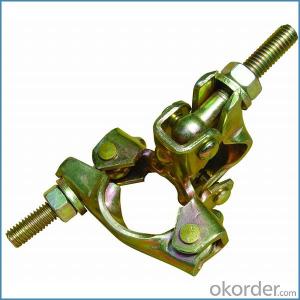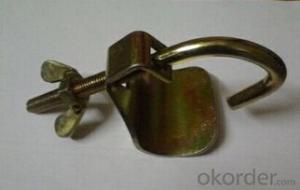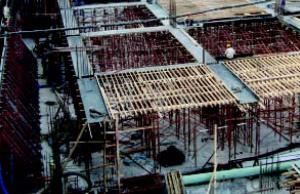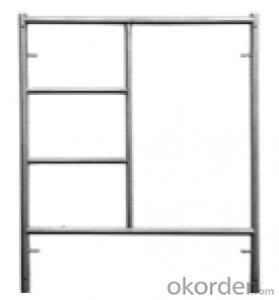American Swivel Coupler British Type for Sale
- Loading Port:
- Tianjin
- Payment Terms:
- TT OR LC
- Min Order Qty:
- 1000 kg
- Supply Capability:
- 100000 kg/month
OKorder Service Pledge
OKorder Financial Service
You Might Also Like
American Swivel Coupler British Type for Sale
Description
1.The scaffolding coupler is always used to connect the steel pipe as scaffolding system.
2.The often used coupler is swivel coupler and righ angle coupler .
3.We can provide types of scaffolding coupler according to your requirement.
4.Couoler can fix the 48.3mm scaffolding steel pipe tightly and make the whole scaffolding system more steadily.
5.Material:Q235 steel
6.Overall Size:48.3mm*48.3mm
7.Surface Finish: Galvanized/ Painted
8.Standard:BS1139,EN74
9.Package:25pcs/bag
10.Manufactuering as per customer requirements
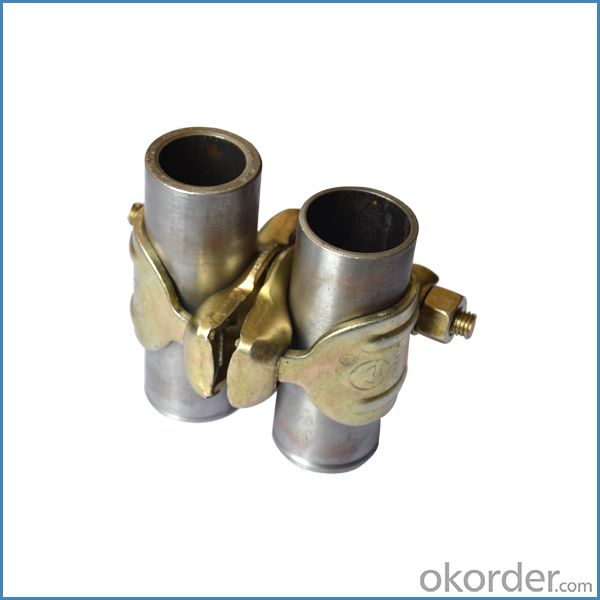
Feature
(1)Excellent Anti-Breaking—Cold Pressed Steel
(2)Outstanding Resistance Deformation
(3)Strong Anti-Dropping Ability
(4)Longtime USe
(5)Qualtity Guaranteed
(6)OEM Service
Photo

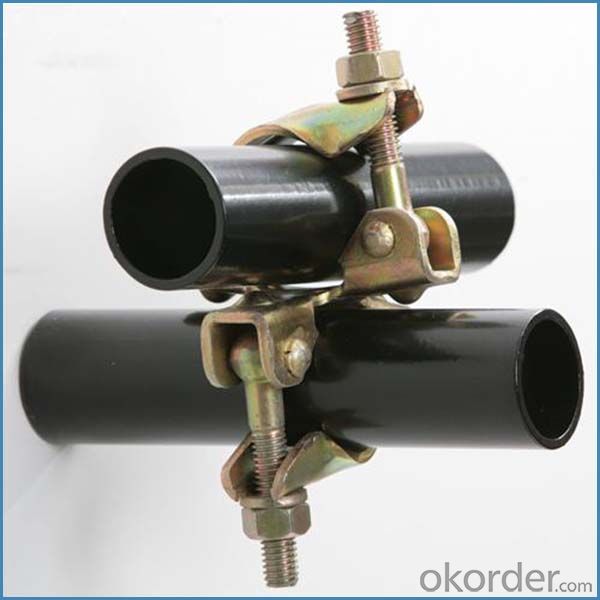
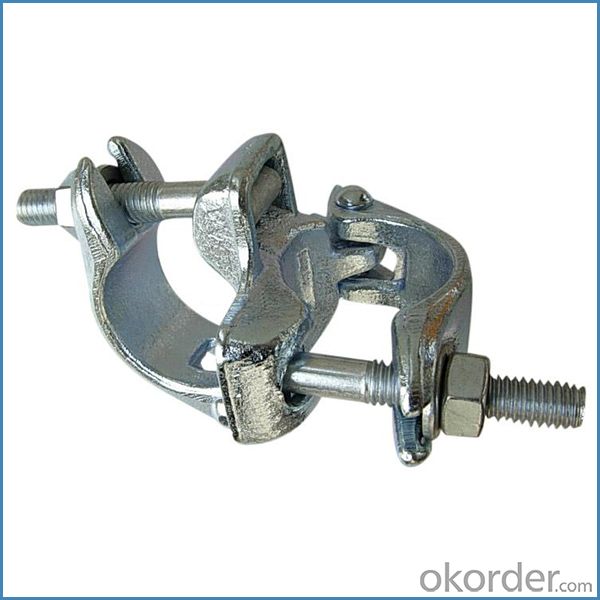
Parameter
| Material | Q235,345steel |
| Size | 48.3mm*48.3mm |
| Surface finish | Galvanized |
| Weight | 1.1kg around |
| Standard | BS1139,EN74 |
| Package | 25pcs/bag,steel pallet |
| Manufacture | As per customer requirement |
| Market | Africa, South America, the Middle East and Asia |
FAQ
Q: Are you a factory or trading company?
We are a state-owned corporation in China,dealing with various kinds of building materials.We have our holding subsidiaries.
Q: Where is your factory located? How can I visit there?
Our factory is located all around China.
Q: Can I get some samples?
Sample is free, customer only pay freight for the first time.
Q: Delivery?
10-30days. (5-15 containers)
Any question,feel free to contact us.
- Q: Are there any specific safety precautions or guidelines to follow when using steel tube couplers in scaffolding?
- Yes, there are specific safety precautions and guidelines to follow when using steel tube couplers in scaffolding. Some of these include ensuring that the couplers are properly inspected before use, using the correct size and type of couplers for the specific application, making sure that the couplers are securely tightened and locked in place, and regularly checking for any signs of wear or damage. It is also important to follow the manufacturer's instructions and any relevant industry standards or regulations when using steel tube couplers in scaffolding to ensure the safety of workers and the stability of the structure.
- Q: How should steel tube couplers be inspected and maintained for optimal performance?
- Steel tube couplers should be inspected and maintained regularly to ensure optimal performance. Inspections should include visual checks for any signs of wear, corrosion, or damage. Additionally, couplers should be measured and checked for proper alignment and fit. Regular cleaning and lubrication should also be carried out to prevent rust and to ensure smooth operation. Any issues identified during inspections should be addressed promptly, either through repairs or replacement, to maintain the couplers' performance and prevent any potential safety hazards.
- Q: How do steel tube couplers perform in areas with high levels of electromagnetic interference?
- Steel tube couplers generally perform well in areas with high levels of electromagnetic interference (EMI). This is due to the fact that steel is a highly conductive material, which helps to shield the couplers from external electromagnetic fields. Steel tube couplers act as a Faraday cage, which can effectively block or reduce the penetration of electromagnetic waves. The electromagnetic interference can be caused by various sources such as power lines, radio signals, or electronic devices. In areas with high EMI, it is essential to use materials that can provide effective shielding to prevent signal degradation or interference. Steel tube couplers, with their excellent electrical conductivity, offer a reliable solution in such environments. Furthermore, steel tube couplers are often designed with proper grounding techniques, further enhancing their ability to withstand electromagnetic interference. Grounding helps to divert the electromagnetic energy away from the couplers, minimizing the impact of EMI. However, it is important to note that the performance of steel tube couplers in areas with high EMI can still be influenced by factors such as the frequency, intensity, and proximity of the electromagnetic sources. In some extreme cases, additional measures like electromagnetic shielding or filtering may be required to ensure optimal performance. Overall, steel tube couplers are generally reliable in areas with high levels of electromagnetic interference, providing a robust and effective solution for various applications.
- Q: Are there any specific guidelines for the proper installation and tightening of steel tube couplers?
- Yes, there are specific guidelines for the proper installation and tightening of steel tube couplers. To ensure a secure and reliable connection, the following guidelines should be followed: 1. Clean and prepare the tube ends: Before installing the couplers, ensure that the tube ends are clean, free from any dirt, debris, or rust. Use a wire brush or emery cloth to remove any surface contaminants. 2. Measure and mark the insertion depth: Measure and mark the insertion depth on the tube. This will ensure that the couplers are properly seated within the tube and provide adequate support. 3. Apply lubricant: Apply a suitable lubricant to the inside of the coupler and the outside of the tube ends. This will facilitate easier insertion and prevent galling or seizing during tightening. 4. Insert the couplers: Align the couplers with the tube ends and insert them by applying even and constant pressure. Avoid using excessive force or striking the couplers, as this may damage the threads or distort the coupler itself. 5. Hand tighten: Once the couplers are fully inserted, hand tighten them until they are snug. It is important not to over-tighten at this stage as it can lead to deformation or thread damage. 6. Use a torque wrench: To achieve the proper tightening torque, use a calibrated torque wrench. Refer to the manufacturer's specifications or guidelines to determine the recommended torque value for the specific coupler size and type. 7. Tighten in a cross-pattern: When tightening multiple couplers, follow a cross-pattern sequence. This ensures equal distribution of the tightening forces and prevents distortion or misalignment of the couplers. 8. Inspect for proper alignment: After tightening, visually inspect the couplers to ensure they are properly aligned and seated within the tube ends. Misalignment may indicate insufficient tightening or improper installation. 9. Perform a pull test: To confirm the integrity of the connection, perform a pull test using appropriate equipment. This test should be conducted according to industry standards or specific project requirements. 10. Document and record: Keep a record of the installation process, including torque values used, inspection results, and any additional notes. This documentation can be useful for future reference or quality control purposes. Following these guidelines will help ensure a safe and secure installation of steel tube couplers, minimizing the risk of failure and providing a reliable connection for various applications. It is always recommended to consult the manufacturer's instructions and seek professional advice when in doubt.
- Q: Are steel tube couplers suitable for scaffolding projects with specific load-bearing requirements?
- Yes, steel tube couplers are suitable for scaffolding projects with specific load-bearing requirements. Steel tube couplers are commonly used in the construction industry for connecting steel tubes and providing a secure and stable connection. These couplers are designed to withstand heavy loads and provide structural stability, making them ideal for scaffolding projects that require specific load-bearing capabilities. Steel tube couplers are versatile and can be used in various scaffolding configurations, such as creating vertical or horizontal supports, diagonal bracing, or connecting different levels of scaffolding. They offer a high level of strength and durability, ensuring the safety and stability of the scaffolding structure. In addition, steel tube couplers are easy to install and dismantle, allowing for quick and efficient assembly and disassembly of scaffolding systems. This is particularly important in construction projects where time is of the essence. Overall, steel tube couplers are a reliable choice for scaffolding projects with specific load-bearing requirements. They provide the necessary strength and stability to ensure the safety of workers and allow for efficient construction processes.
- Q: Can steel tube couplers be used for scaffolding structures that need to support cantilevered platforms?
- Yes, steel tube couplers can be used for scaffolding structures that need to support cantilevered platforms. Steel tube couplers are commonly used in scaffolding systems and are designed to provide secure connections between tubes. These couplers ensure stability and structural integrity, making them suitable for supporting cantilevered platforms in scaffolding structures.
- Q: Are steel tube couplers resistant to corrosion and weather conditions?
- Yes, steel tube couplers are generally resistant to corrosion and weather conditions due to their durable and rust-resistant material composition.
- Q: How do steel tube couplers accommodate different angles or connections in scaffolding systems with complex or intricate designs?
- Steel tube couplers are an essential component in scaffolding systems with complex or intricate designs as they provide the flexibility needed to accommodate different angles or connections. These couplers are designed to securely join multiple steel tubes together, allowing scaffolding structures to be constructed in various shapes and configurations. One of the main ways in which steel tube couplers accommodate different angles is through their adjustable nature. Many couplers feature a swivel or rotating mechanism that allows them to be rotated to various positions. This enables scaffolding tubes to be connected at different angles, ensuring that the structure can be built to suit the specific requirements of the project. Additionally, steel tube couplers often come in a variety of types and designs, each specifically created to fulfill different connection needs. For instance, there are right-angle couplers that connect tubes at a 90-degree angle, putlog couplers that are designed to join tubes and putlogs (horizontal members), and sleeve couplers that connect tubes end-to-end. By offering a range of coupler options, scaffolding systems can be assembled to accommodate any complex or intricate design. Furthermore, steel tube couplers are typically manufactured with high-strength materials, ensuring that they provide a secure and reliable connection. This strength is crucial in scaffolding systems with complex designs, as it allows for the safe support of workers and materials at various angles and connections. Couplers are rigorously tested to meet industry standards, ensuring their ability to withstand the demands of complex scaffolding structures. Overall, steel tube couplers play a vital role in accommodating different angles or connections in scaffolding systems with complex or intricate designs. Their adjustable nature, variety of types, and high-strength materials allow for the construction of safe and reliable scaffolding structures that can adapt to the unique needs of each project.
- Q: Are there any specific certifications or qualifications required for installing steel tube couplers in scaffolding?
- Yes, specific certifications or qualifications are required for installing steel tube couplers in scaffolding. In many countries, scaffolding installation is regulated by local authorities or industry organizations, and individuals are required to obtain relevant certifications or qualifications to ensure safety and compliance with industry standards. These certifications or qualifications typically involve training and assessments to demonstrate the knowledge and skills necessary for proper installation and use of steel tube couplers in scaffolding.
- Q: Can steel tube couplers be used for scaffolding structures that require frequent adjustments or modifications?
- Indeed, steel tube couplers possess the capability of being employed in scaffolding structures necessitating regular adjustments or modifications. Specifically devised to link and firmly fasten steel tubes, these couplers guarantee a robust and dependable connection. Furthermore, they facilitate effortless disassembly and reassembly, rendering them exceptionally suitable for scaffolding structures frequently in need of alterations or adaptations. The couplers can be effortlessly detached and repositioned to accommodate modifications in the height, width, or layout of the scaffolding structure. This adaptability and flexibility have established steel tube couplers as a widely favored option for scaffolding projects entailing frequent modifications.
Send your message to us
American Swivel Coupler British Type for Sale
- Loading Port:
- Tianjin
- Payment Terms:
- TT OR LC
- Min Order Qty:
- 1000 kg
- Supply Capability:
- 100000 kg/month
OKorder Service Pledge
OKorder Financial Service
Similar products
Hot products
Hot Searches
Related keywords
